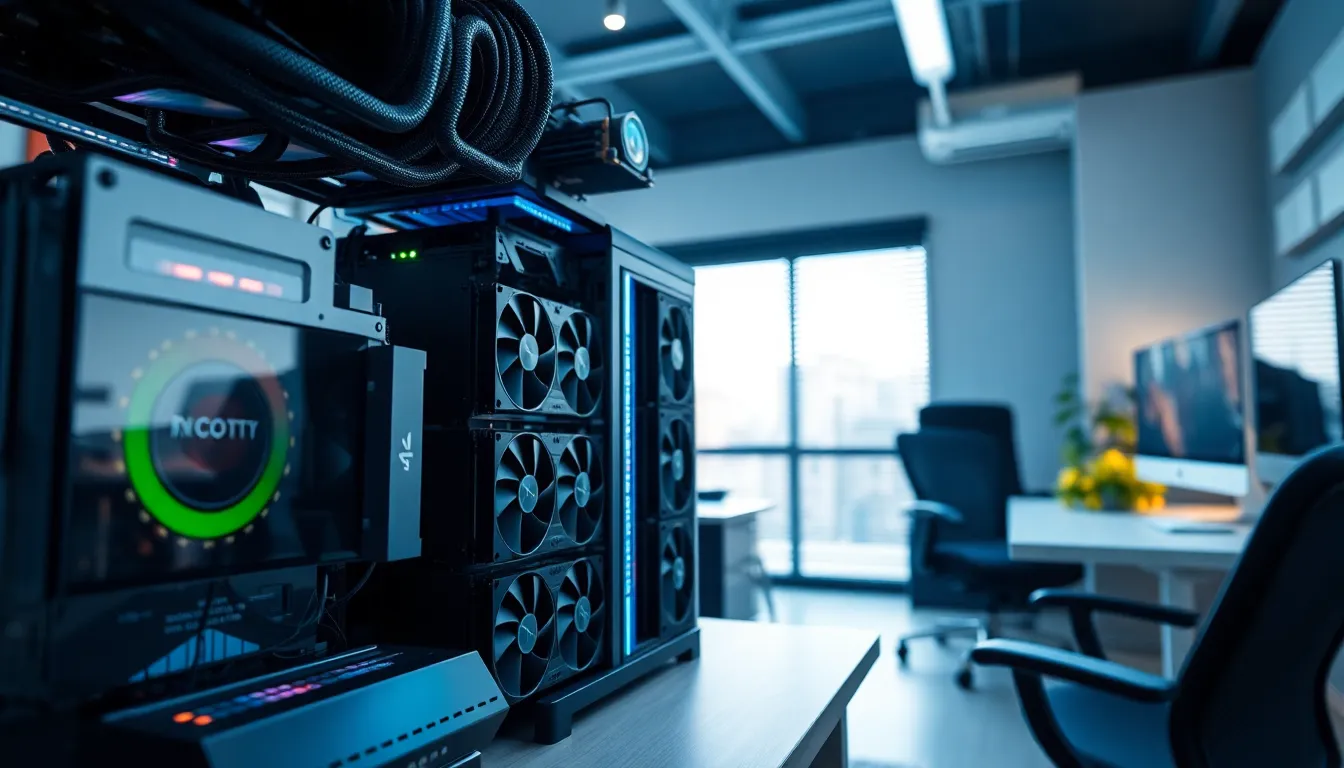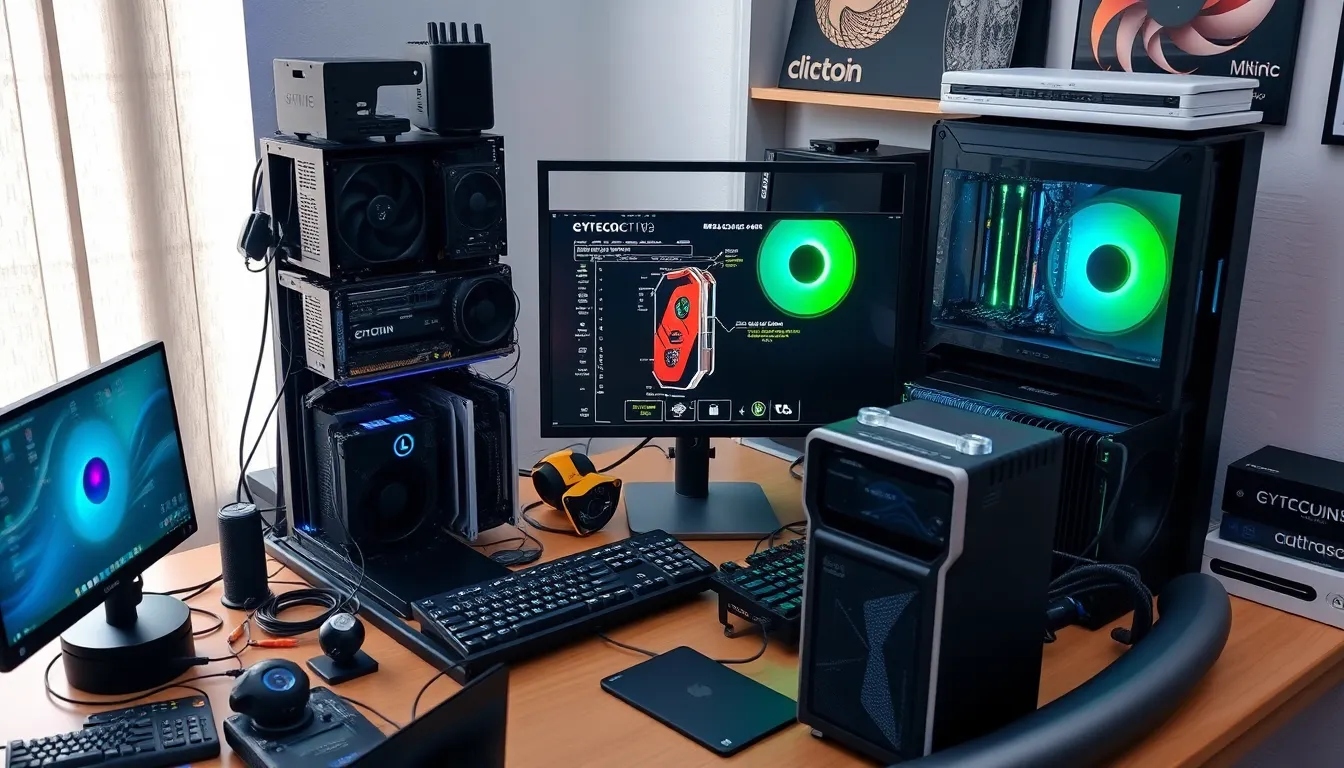Cryptocurrency mining has transformed from a niche hobby into a lucrative venture for many. As digital currencies like Bitcoin and Ethereum continue to gain traction, understanding the mining process becomes essential for anyone looking to dive into the crypto world. Mining not only validates transactions but also creates new coins, making it a vital component of blockchain technology.
With the right knowledge and tools, anyone can tap into this growing market. From choosing the right hardware to understanding software configurations, the path to successful mining is filled with opportunities and challenges. Whether someone is a tech enthusiast or a financial investor, mastering the art of crypto mining can unlock potential rewards and insights into the future of finance.
Understanding Cryptocurrency Mining
Cryptocurrency mining is a critical process that underpins the entire digital currency ecosystem. It involves validating transactions, securing the network, and generating new coins.
What Is Cryptocurrency Mining?
Cryptocurrency mining refers to the computational process where specialized hardware solves complex mathematical problems to validate transactions on a blockchain network. Miners compete to be the first to solve these problems, earning rewards in the form of cryptocurrency. This process requires significant computational power, leading to higher energy consumption. Various cryptocurrencies use different mining algorithms, with Bitcoin utilizing the Proof of Work mechanism, while others, like Ethereum (prior to its transition to Proof of Stake), also used unique methods requiring varying hardware specifications.
The Importance of Mining in Blockchain
Mining plays a vital role in blockchain technology by ensuring transaction integrity and consensus among network participants. Without mining, the decentralized nature of cryptocurrencies would be compromised. It maintains security by preventing double spending and fraud, reinforcing the trustworthiness of the network. Additionally, mining incentivizes participants, distributing new coins and enabling them to contribute to network maintenance. A robust mining environment fosters innovation and attracts investments, significantly impacting the overall health and growth of the cryptocurrency market.
Types of Cryptocurrency Mining

Cryptocurrency mining comprises various methods, each offering unique features and advantages. Understanding these types helps miners choose the best approach for their needs.
Proof of Work vs. Proof of Stake
- Proof of Work (PoW): PoW relies on computational power to solve complex math problems. Miners use extensive hardware resources to validate transactions. Bitcoin exemplifies this method, requiring significant energy consumption and hardware investment.
- Proof of Stake (PoS): PoS allows miners to validate transactions based on the number of coins they hold. This method is energy-efficient, as it doesn’t require extensive computational power. Ethereum plans to transition to PoS, promoting scalability and sustainability within the network.
Cloud Mining vs. Solo Mining
- Cloud Mining: Cloud mining allows users to rent mining power from remote data centers. This method requires minimal upfront investment and reduces maintenance costs. However, it often comes with ongoing fees and may involve trusting third-party services.
- Solo Mining: Solo mining involves individuals using their hardware to mine cryptocurrency independently. This method offers full control and potential higher rewards without sharing profits. The downside includes high resource demands and lower chances of successfully mining blocks.
Getting Started with Mining
Starting cryptocurrency mining involves choosing the right coin and the necessary equipment. A careful selection leads to better profitability and effective mining operations.
Choosing the Right Cryptocurrency to Mine
Selecting the right cryptocurrency for mining involves assessing several factors. Consider current market trends, mining difficulty, and potential profitability. Popular options include Bitcoin, Ethereum, and Litecoin, each with distinct characteristics. Bitcoin, while profitable, requires substantial hardware investment and energy expenditure due to its Proof of Work (PoW) model. Ethereum remains a strong choice but plans to transition to Proof of Stake (PoS), impacting traditional mining. Newer coins often present lower competition but might lack liquidity or long-term viability. Researching supported algorithms is crucial since hardware specifications depend on the chosen cryptocurrency.
Required Hardware and Software
Hardware for mining varies based on the cryptocurrency selected. Miners typically use Application-Specific Integrated Circuits (ASICs) for PoW coins like Bitcoin due to their efficiency. Graphics Processing Units (GPUs) are preferred for versatile mining, especially for altcoins. Specific rigs or cloud mining services also provide opportunities for those with minimal infrastructure.
Software plays a critical role in mining operations. Miners require a reliable mining program tailored to their hardware and chosen cryptocurrency. Popular mining software includes CGMiner, BFGMiner, and NiceHash, which facilitate high-performance mining. Joining mining pools can enhance success rates by combining resources, which leads to shared rewards. Selecting compatible software ensures smooth operations and maximizes returns.
Setting Up Your Mining Operation
Establishing a mining operation involves careful planning and the right equipment. By following a structured approach, miners can optimize their setup for maximum efficiency and profitability.
Step-by-Step Guide to Setting Up Equipment
- Choose Your Mining Hardware: Select hardware based on the cryptocurrency type. ASIC miners excel in PoW coins like Bitcoin while GPUs are suitable for altcoins. Research models that offer optimal hash rates and energy efficiency.
- Select a Power Supply Unit (PSU): Ensure the PSU can handle the power requirements of the chosen hardware. Choose a reliable and efficient PSU to minimize energy costs and prevent equipment damage.
- Set Up Mining Rig: Assemble the mining rig by connecting the hardware components. Ensure proper ventilation and cooling systems to avoid overheating. Position the rig in a conducive environment with stable internet connectivity.
- Install Mining Software: Download and install reliable mining software compatible with the chosen hardware. Programs like CGMiner or BFGMiner provide extensive functionality for miners. Configure settings according to the hardware specifications.
- Join a Mining Pool: Register with a mining pool to combine resources with other miners. This approach enhances the likelihood of receiving regular payouts compared to solo mining. Research and select a pool that aligns with your mining goals.
Configuration and Optimization Tips
- Optimize Mining Software Settings: Adjust miner settings for better efficiency. Set optimal clock speeds and power limits based on the hardware capabilities. Use performance benchmarks to guide adjustments.
- Monitor System Performance: Utilize software tools to track the rig’s performance and temperature. Continuous monitoring identifies issues early, preventing potential hardware failures.
- Stay Updated on Blockchain Changes: Follow updates related to the cryptocurrency being mined. Changes in algorithms or protocols might necessitate adjustments in mining strategies or hardware.
- Implement Cooling Solutions: Install additional cooling mechanisms if necessary. Overheating can lead to performance drops or equipment failure. Consider fans, liquid cooling systems, or environmental adjustments to control temperatures.
- Utilize Overclocking Techniques: Explore safe overclocking options to boost hash rates. Incrementally increase clock speeds while monitoring stability and temperature to find the best settings without compromising hardware integrity.
Monitoring and Maintaining Your Mining Rig
Maintaining a mining rig requires consistent monitoring and management to ensure optimal performance and efficiency. Attention to hardware health and software functionality enhances profitability and extends equipment lifespan.
Keeping Your Rig Cool and Efficient
Keeping a mining rig cool is crucial for maintaining performance and reducing hardware wear. Employ efficient cooling solutions to manage heat, such as:
- Adequate ventilation: Ensure each component has enough airflow to prevent overheating, especially in enclosed spaces.
- Cooling fans: Install quality fans designed for mining rigs, optimizing airflow and reducing component temperatures.
- Liquid cooling systems: Consider liquid cooling setups for high-performance rigs, facilitating superior heat dissipation compared to air cooling.
- Thermal paste application: Regularly replace thermal paste on CPUs and GPUs for improved thermal transfer.
Implementing these strategies will enhance rig efficiency and maintain stable operation, thereby optimizing mining output.
Troubleshooting Common Issues
Identifying and resolving issues promptly keeps a mining rig operating smoothly. Common issues include:
- Overheating: Monitor temperatures regularly using hardware monitoring software. If temperatures exceed recommended thresholds, assess cooling solutions.
- Hardware malfunctions: Check for signs of failing components, such as unconventional noises or system crashes. Replace faulty hardware immediately to avoid increased risk.
- Mining software errors: Ensure mining software is updated to the latest version. Review logs for errors and adjust configurations as needed for compatibility with hardware.
- Network connectivity problems: Confirm stable internet connections to avoid disruptions in mining operations. Use wired connections instead of wireless when possible.
Addressing these common issues swiftly maintains the functionality and efficiency of mining rigs, promoting successful cryptocurrency mining endeavors.
Conclusion
Cryptocurrency mining offers a unique opportunity for individuals to engage in the evolving digital economy. By understanding the various mining methods and selecting the right equipment and coins, miners can navigate the complexities of this space effectively.
Maintaining a mining rig requires ongoing attention to performance and troubleshooting to ensure optimal results. As the landscape continues to shift with advancements in technology and market trends, staying informed and adaptable is key.
With the right approach and dedication, cryptocurrency mining can not only be a rewarding venture but also contribute to the broader growth of the blockchain ecosystem.















